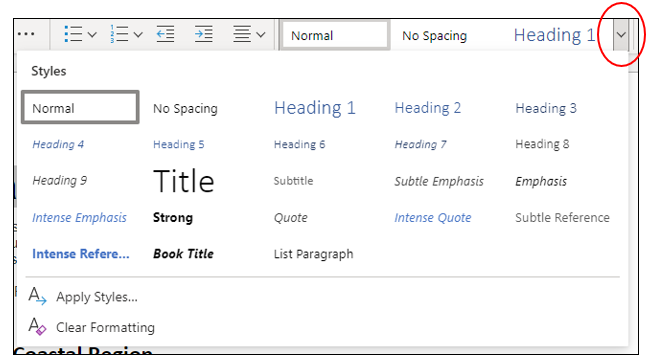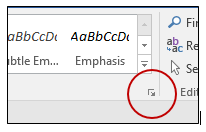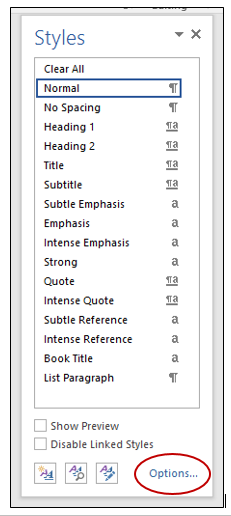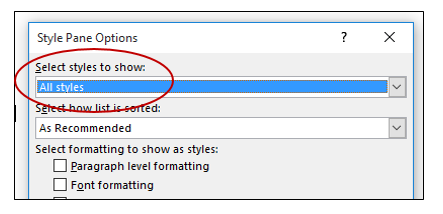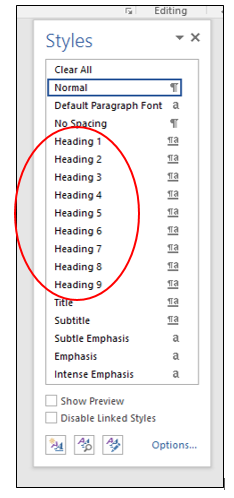Module 2, Lesson 2: Styles (Windows)
If you use a Mac, click this link to go to the Word for Mac module.
What are Styles?
Using styles is a way to "tag" elements in your document in order to define whether the text is a Heading 1, Heading 2, a paragraph, a column, a bulleted or numbered list, etc. We use these tags in the same way we think of an outline; the title of the document is typically Heading 1, while subtitles are Heading 2, sub-subtitles are Heading 3, and so on.
Why should we use Styles?
Using Styles is critical for individuals using a screen reader because it allows them to detect the type of text they are reading from the tagging you have used to create your document. These tags are actually part of the code of the document. Because the headings and bullets are embedded in the code, the screen reader will alert the listener to the existence of those headings and bullets. Without styles, the text reads as continuous text with only line breaks.
The video below is a recording of JAWS (a common screen-reading software) reading a list of three California counties and their cities from a Word document formatted WITHOUT styles (no headings or bullets). As you listen and/or read the captions, try and decipher which words are the counties, and which are the cities. You may need to listen a couple of times.
How did you do? Did it go too fast? The speed was typical of that which a seasoned JAWS user might use (if not faster!).
The next video has JAWS reading the same list, but this time the Word document was formatted WITH styles (headings and bullets). Again, as you listen and/or read the captions, try and decipher which words are the counties, and which are the cities. You may need to listen a couple of times.
Did you do better that time?
Can you name the three counties? (**answers are at the bottom of this page**)
What tipped you off that those were the county names?

Styles are also beneficial for the sighted user because they provide an organized and clear structure that is easier to read and that is maintained across formats. It's a win-win!
How do I use Styles?
Start with Heading 1 and continue with Heading 2, 3, and so on. Only use "Heading (#)" options for heading text and "Paragraph" for regular text. Avoid using the "Title" , "Subtitle", and other styles that are not labeled "Heading (#)".
Skip to instructions for your preferred version of Word:
- Word via Office 365 (full program download)
- Word via Office 365 (web-based version)
- Word 2019 for Windows
- Word 2016 for Windows
Word via Office 365 (full program download)
*coming soon!
Word via Office 365 (web-based version)
- Select the text in your document to which you want to apply the Style.
- In the ribbon, click on the More Styles button (circled in red below) to see a selection
of available headings.
- For a main heading, click Heading 1. For a subheading click Heading 2, and so on. You do not need to apply a style to text that is not a heading (i.e. a paragraph).
- Once the style has been applied, you can change the font type, size, bold it, italicize it, etc. It will still be labeled with the proper heading.
Word 2019 for Windows
- Select the text in your document to which you want to apply the Style.
Word 2016 for Windows
- Select the text in your document to which you want to apply the Style.
- Locate the Styles group at the top right-hand side of the screen.

- You may notice in the Styles group that only Heading 1 and Heading 2 are showing,
and not 3, 4, and so on. To access all the Heading # options, first click the dialog
box launcher at the bottom right-hand side of the Styles group.
- Click Options at the very bottom of the menu that appears.
- In the Style Pane Options menu, select "All Styles" under "Select styles to show".
Click OK.
- You should now see all of the Heading # options listed in the Styles menu to the right.
- In your document, with your mouse select the text to which you want to apply the style.
- For a main heading, click Heading 1. For a subheading click Heading 2, and so on. You do not need to apply a style to text that is not a heading (i.e. a paragraph).
- Once the style has been applied, you can change the font type, size, bold it, italicize it, etc. It will still be labeled with the proper heading.
** answers to "counties" question: Butte, Imperial, Santa Barbara

